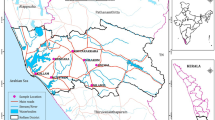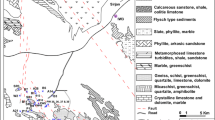Abstract
Thane district is one of the most industrialized districts in Maharashtra. The heavy industrialization and the increasing urbanization are responsible for the rapidly increasing stress on the water and soil environment of the area. Therefore, an attempt has been made through comprehensive study on the groundwater contamination and soil contamination due to heavy metals in Thane region of Maharashtra. The area undertaken for the study was Thane and its suburbans Kalwa, Divajunction, Dombivali, Kalyan, and Ulhasnagar. Industrialization and urbanization lead to generation of large volumes of wastewater from domestic, commercial, industrial, and other sources, which discharged in to natural water bodies like river and creek in this region. Groundwater samples and soil samples were collected from residential, commercial, agriculture, and industrial areas. Groundwater samples were analyzed for various water quality parameters. The analytical data shows very high concentration of total dissolved solids, total hardness, total alkalinity, chemical oxygen demand, chloride etc. Groundwater and soil samples were analyzed for ten heavy metals by inductively coupled plasma (ICPE-9000) atomic emission spectroscopy. The analytical data reveal that, very high concentration level of arsenic, cadmium, mercury, and nickel throughout the industrial area. The random dumping of hazardous waste in the industrial area could be the main cause of the groundwater and soil contamination spreading by rainwater and wind. In the residential areas the local dumping is expected to be the main source for heavy metals. A comparison of the results of groundwater with WHO guidelines show that most of the groundwater sampling station are heavily contaminated with organic matter and heavy metals. Groundwater samples are heavily contaminated by arsenic, cadmium, mercury, and nickel. Similarly, the results of heavy metals in soil compared with Swedish soil guideline values for polluted soil show that soil samples collected from residential, commercial and industrial areas are heavily contaminated by arsenic, cadmium, mercury, and nickel.
Similar content being viewed by others
References
Amrhein, C., Strong, J. E., & Mosher, P. A. (1992). Effect of de-icing salts on metal and organic matter mobilization in roadside soils. Environmental Science and Technology, 26, 703–709.
APHA-AWWA (1998). Standard metals for the examination of water and waste water (20th ed.), sec. 3120.
Ebong, G. A., Akpan, M. A., & Mkpenie, V. N. (2008). Heavy metal contents of Municipal and Rural Dumpsite soils and rate of accumulation by carica papaya and Talinum triangular in Uyo, Nigeria. E-Journal of Chemistry, 5(2), 281–290.
Forstner, U. (1979). Metal pollution assessment from sediment and analysis. In U. Forster & G. T. Wittmann (Eds.), Metal pollution in the aquatic environment (pp. 161–191). Berlin: Springer.
Friberg, L. (1948). Proteinuria and kidney injury among workmen exposed to cadmium and nickel dust. Journal of Industrial Hygiene and Toxicology, 30(3), 32–36.
Ghose, S. (2003). Environmental chemistry (1st ed.). New Delhi: Dominant Publishers and Distributors.
Gogate, S. S., Rao, S. R., & Shah, S. M. (1974). Elemental concentration in Bombay Harbour sediments. Indian Journal of Marine Sciences, 5, 41–45.
Govil, P. K., Reddy, G. L. N., & Krishna, A. K. (2001). Contamination of soil due to heavy metals in Patancheru industrial development area, Andhra Pradesh, India. Environmental Geology, 41, 461–469.
Grolimund, D., Brokovec, M., Bartmettler, K., & Sticher, H. (1996). Colloid facilitated transport of strongly sorbing contaminants in natural porus media; a laboratory column study. Environmental Science and Technology, 30, 3118–3123.
Haya, K., & Waidood, B. A. (1985). Ademylate energy charge at AT phase activity. Potential biochemical indicators of sub lethal effects caused by pollutants in aquatic animals. In: J. Nvigan (Ed.), Aquatic toxicology (Vol. 13, pp. 524–525). New York: Wiley.
Jarup, L. (2003). Hazards of heavy metal contamination. British Media Bulletin, 68(1), 167–182.
Khan, M. A. (2001). Pollution of water resources due to industrialization in arid zone of Rajasthan, India. Journal of Environmental Science (China), 13(2), 218–223.
Krishna, A. K., & Govil, P. K. (2004). Heavy metal contamination of soil around Pali industrial area, Rajasthan, India. Environmental Geology, 47, 38–44.
Krishna, A. K., & Govil, P. K. (2005). Heavy metal distribution and contribution in soils of Thane-Belapur Industrial development area, Mumbai, Western India. J. Environmental Geology, 47(8), 1054–1061.
Larocque, A. C., & Rasmussen, P. E. (1998). An overview of trace metals in the environment: Mobilization to remediation. Environmental Geology, 33, 85–91.
Luoma, S. N., & Carter, J. L. (1991). Effects of trace metals on aquatic benthos. In: M. C. Newman & A. W. Mcintosh (Eds.), Metal ecotoxicology: Concept and application. Chelesa: Lewis (MI.1).
Maharashtra Pollution Control Board Report (2005). Environmental status of Thane Region.
Matkar, V. M., Ganapathy, S., & Pillai, K. (1981). Distribution of zinc, Cu, Mn and Fe in Bombay Harbour bay. Indian Journal of Marine Sciences, 10, 35–40.
Mielke, H. W., Adams, J. L., Chaney, R. L., Mielke, P. W., & Ravikumar, V. C. (1991). The pattern of Cadmium in the environment of five Minnesota cities. Environmental Geochemistry and Health, 13, 29–34.
Mohapatra, S. P. (1988). Distribution of heavy metals in polluted creak sediment. Environment Monitoring and Assessment, 10, 157–163.
Mugica, V., Maubert, M., Torres, M., Munoz, J., & Rico, E. (2002). Temporal and spatial Variations of metal content in TSP and PM10 in Mexico City during 1996–1998. Journal of Aerosol Science, 33, 91–102
Mwachiro, E. C., & Durve, V. S. (1997). Heavy metal status of the reservoir Bari near Udaipur (Rajasthan) and the accumulation of the metals in fish organs. Pollution Research, 16(2), 67–74.
Naik, P. K., Dehury, B. N., & Tiwari, A. N. (2007). Groundwater pollution around industrial area in the costal stretch of Maharashtra state, India. Environmental Monitoring and Assessment, 132(1–3), 207–233.
Nathan, C. C. (1973). Corrosion inhibitors. NACE Publication, 156.
Naturvardsverket (2003). Introduction to methods: For inventories and risk classification of contaminated sites. Report 5053, Stockholm.
Ramesh, R., & Anbu, M. (1996). Chemical methods for environmental analysis (p. 161). India: Macmillan.
Romic, M., & Romic, D. (2003). Heavy metal distribution in agricultural topsoils in urban area. Environmental Geology, 43, 795–805.
Rao, M. S., Gopalkrishnan, R., & Venkatesh, B. R. (2001). Medical geology—an emerging field in environmental science. In National symposium on role of earth sciences (pp. 213–222). Integrated and Related Social issues GSI Special. pub. no. 65(II).
Rao, M., Ranga, A., & Acharya, N. G. (2003). Effect of industrial effluent on properties of groundwater. Journal of Environmental Biology, 24(2), 187–192.
Robards, K., & Worsfold, P. (1991). Cadmium: Toxicology and analysis, a review. Analyst, 116, 549–568.
Schroeder, H. A. (1965). Cadmium as a factor in hypertension. Journal of Chronic Diseases, 18, 647–656.
Schwartz, K. (1997). Clinical chemistry and chemical toxicology of metals. Environmental Geology, 43, 795–805.
SEGH (2001). Environmental geochemistry and health special issue. In 18th European conference (Vol. 23, No. 3).
Singh, R. K. (2003). Assessment of pollution level of Aadaigadha estuary in coastal region of Maharashtra in relation to aquaculture. Journal of Ecotoxicology and Environmental Monitoring, 13(3), 133–240.
Singh, R., Chavan, S. L. & Sakale, P. H. (2006). Heavy metal concentration in water, sediments and body tissues of Red Worm (Tubifex SPP) collected from Natural Habitats in Mumbai, India. Environmental Monitoring and Assessment, 129(1–3), 471–481.
Shaw, N. (1987). Ph.D. thesis, Berhampur University, Berhampur, Orissa.
Smith, C. A. (1981). Soil in the corrosion process: A review of the role of soil conditions on the corrosion of underground pipes. Anticorrosion Methods and Materials, 28(2), 4–8.
Speller, F. N. (1951). Corrosion causes and prevention (3rd ed., p. 420). New York: McGraw Hill.
Tebbutt, T. H. Y. (1983). Relation between natural water quality and health. Paris: UNESICO.
Tejam, B. H., & Halder, B. C. (1975). A preliminary survey of mercury in fish from Bombay and Thane environment. Indian Journal of Environmental Health, 17(1), 9.
Train, R. E. (1979). Quality criteria for water (p. 256). Washington: UAEPA.
Tripathi, G., & Pandey, G. C. (2001). Current topics in environmental sciences (1st ed., p. 222). Jaipur: ABD.
World Health Organization (2001). Guidelines for drinking water quality—I, recommendations (2nd ed.). Geneva: WHO.
Author information
Authors and Affiliations
Corresponding author
Rights and permissions
About this article
Cite this article
Bhagure, G.R., Mirgane, S.R. Heavy metal concentrations in groundwaters and soils of Thane Region of Maharashtra, India. Environ Monit Assess 173, 643–652 (2011). https://doi.org/10.1007/s10661-010-1412-9
Received:
Accepted:
Published:
Issue Date:
DOI: https://doi.org/10.1007/s10661-010-1412-9




